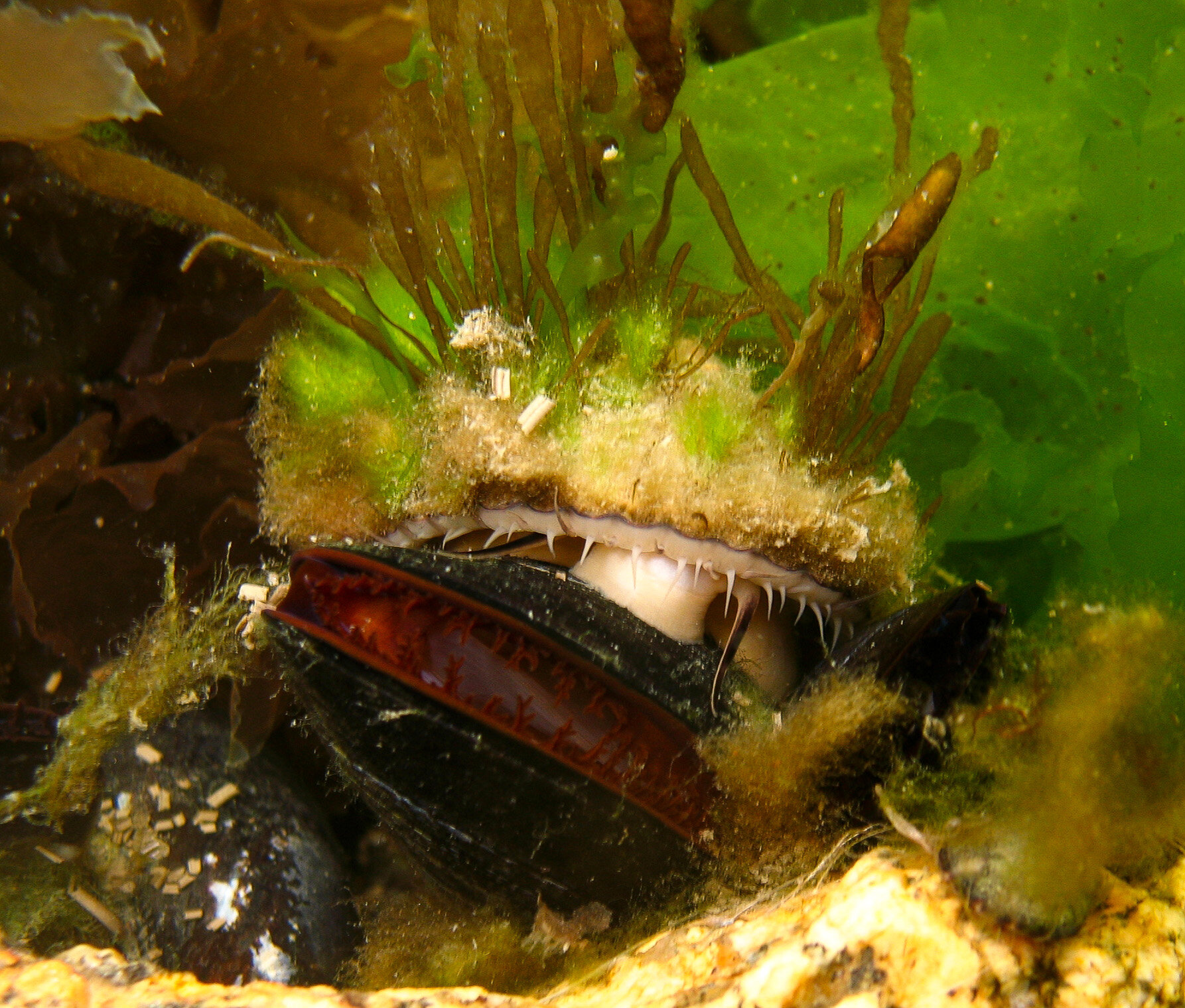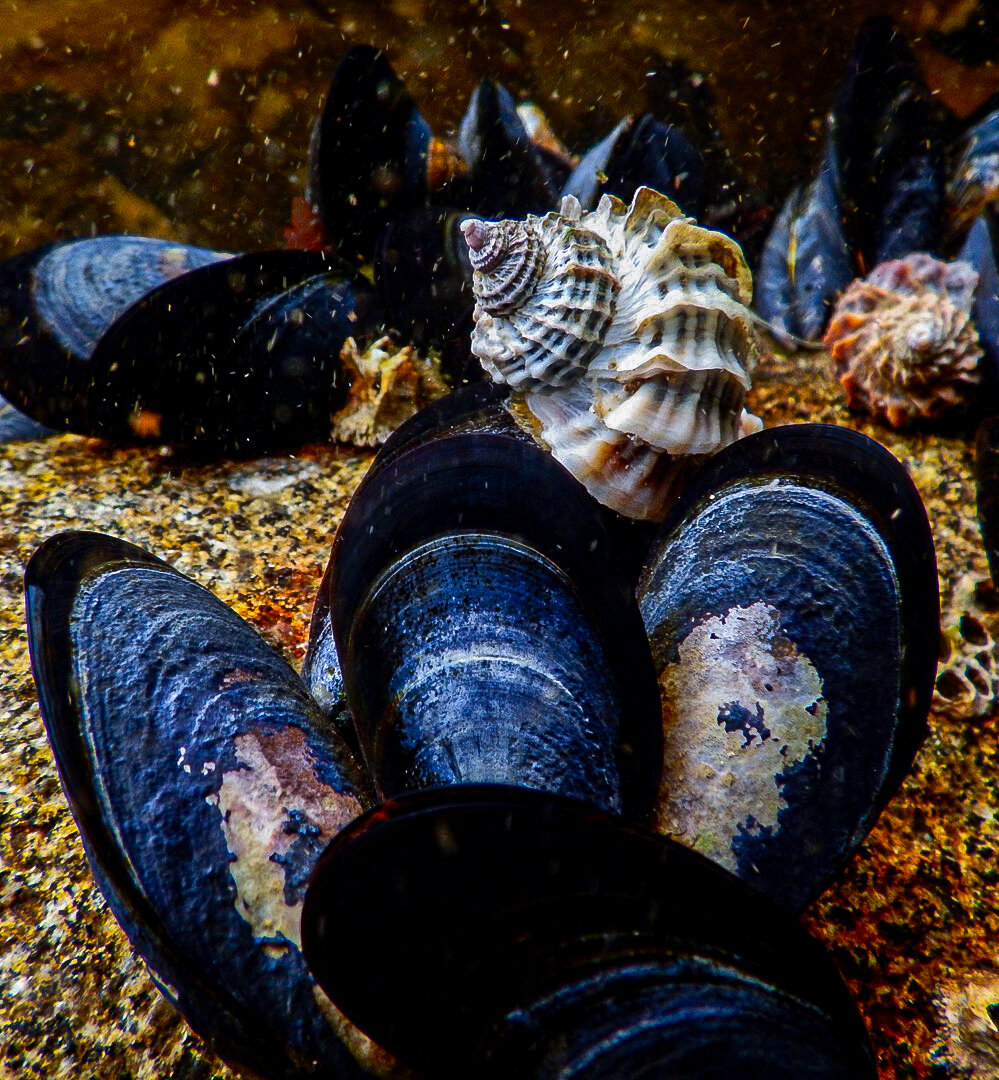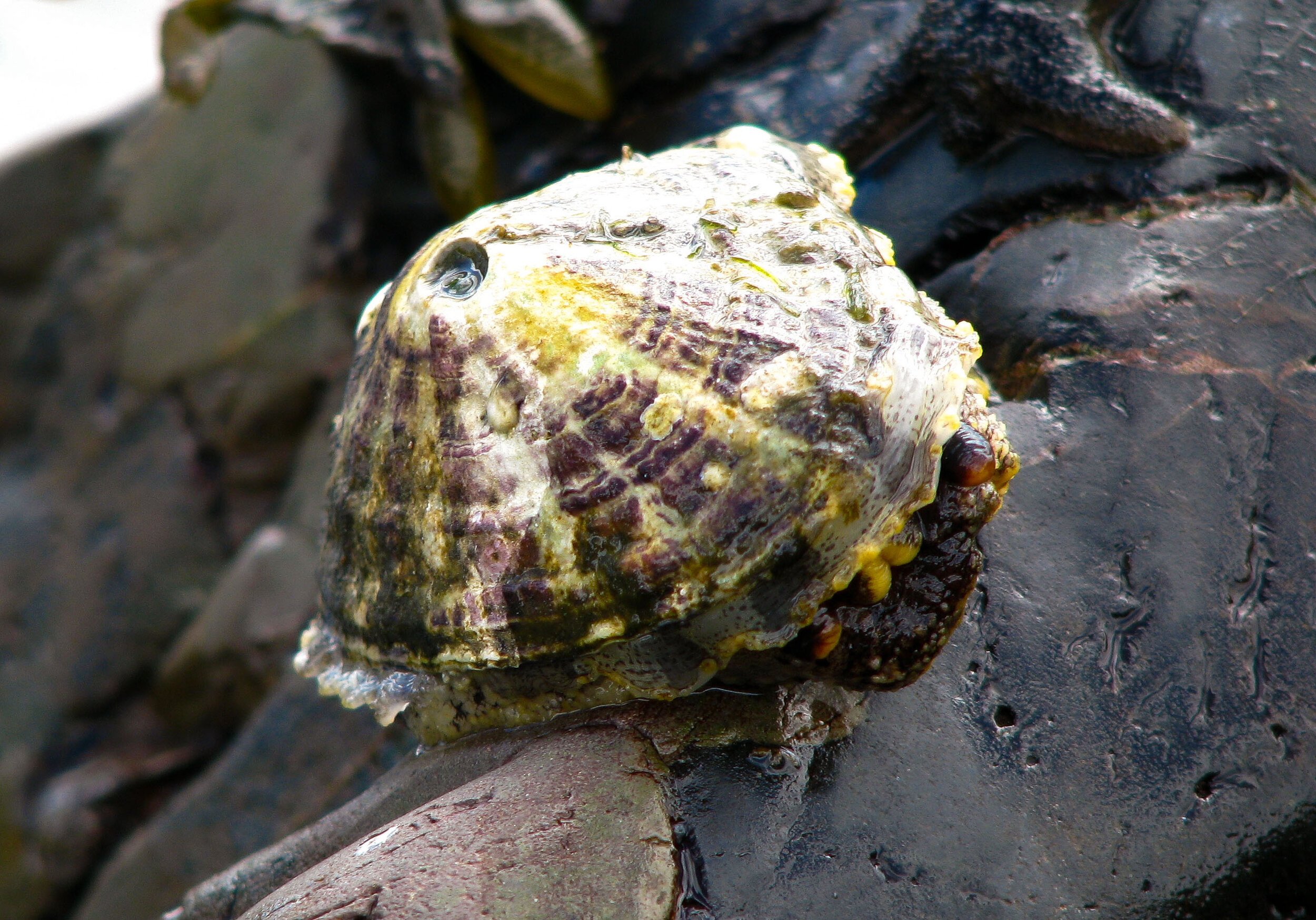corrales de pesca - fish traps of the patagonian archipelago
By Ricardo Alvarez, Jimena Torres, and Jaime Ojeda
Ancestral Connections & Geographic Extent Temporal Extent Biophysical Manipulations Target Species Ceremony & Stewardship Current Status
Corral de Pesca, Seno Otway - Photo by Alex Garcia
Ancestral Connections & Geographic Extent
Most Corrales de Pesca, which persist today, have been maintained by the Chilotes and Williches of the Chiloé archipelago in southern Chile. These structures are also present in the Kawésqar, Selk’nam, and Yagan seascapes. Although their traditional fishing use has declined due to the commercial overexploitation of fish (Alvarez et al. 2019), in parallel new uses have emerged that have supported a cultural revitalization with social-ecological implications. For instance, people currently use Corrales de Pesca to store macroalgae for sale. These intertidal features have also acquired crucial geopolitical value through Indigenous marine governance because they are considered key biocultural areas for protection through the Marine and Coastal Areas for Indigenous Peoples policy (ECMPO in Spanish). This policy allocates access rights to seascapes and coast lines in Chile, and aims to support Indigenous customary uses (Araos et al. 2020, Hiriart-Bertrand et al. 2020). Currently, these marine innovations are protected by law as Chilean National Monuments (Law 17.288), because they are considered archaeological sites. Although these two policies safeguard the protection of Corrales de Pesca, hundreds of these features have disappeared due to industrial-scale aquaculture operations. This threat has motivated local Indigenous and non-indigenous communities, mainly those who are applying for their protection via ECMPOs (Native Peoples Coastal Marine Spaces), to georeference them and to make them visible in cartographies to reinforce their conservation.
Corrales de Pesca are located in southern Chile, from the Llanquihue province with the highest density of more than a thousand (Alvarez 2016), to the Cape Horn archipelago. This entire area is commonly known as Patagonia, and includes both the Argentinean and Chilean coasts of the Beagle Channel (Vasquéz and Zangrando 2017). Corrales de Pesca are typically located in fjords, channels, and bays with expansive intertidal areas, which allows them to function as traps between high and low tides. These structures are of Indigenous and mestizo-historical origin (Munita et al. 2016). They are practically absent on coasts with high wave exposure. Over time, the Corrales de Pesca's traditional use has changed. In the past, its use was to capture fishes and macroinvertebrates for food to feed hundreds of families. However, industrial transformations have affected these ecosystems. Since the end of the 20th century, target species have been reduced in their availability, so their passive capture has become uncommon. That is why coastal communities have begun to use Corrales de Pesca to accumulate commercial algae such as the red algae, Sarcopeltis skottsbergii, mainly in the Chiloé archipelago. Today, Corrales de Pesca are also being used as artificial lagoons to generate greater shellfish abundance to harvest. Indeed, there are mini-fish ponds, called ‘cholchenes’ (no more than 3 meters in diameter) that can be found across Patagonian channels (Torres and San Román 2020). They are used to store and maintain collected shellfish to consume or smoke them later (Alvarez et al. 2008). In addition, there are structures called ‘Corrales de Pirenes’. They are built with boulders making a small pile, and people still use to capture fish eggs (Sepúlveda-Barrientos 2017).
Corral Cantos Rodados Isla Caguach - Photo by Ricardo Alvarez
Corral de Pesca in Seno Otway - Photo by Jaime Ojeda
Temporal Extent
To date, fish ponds have not been radiocarbon dated. However, historical accounts date back to 1558 by chronicler Jeronimo de Vivar (1970). De Vivar, who documented the early years of Spanish colonization in Chile, highlighted fish pond uses by Indigenous communities in Reloncaví sound. He noted that fish ponds were almost identical to structures used in Rota, Spain. Thus, it was evident that before the European arrival in Patagonia, Indigenous communities constructed, used and maintained these structures assiduously. Throughout the centuries, numerous chroniclers and travelers highlighted how Indigenous and mestizo societies built and used fish ponds to sustain themselves in environments where other productive strategies did not work (such as Western-type agriculture). This traditional practice made coastlines, especially the intertidal zone, a crucial space for Patagonian subsistence, more so than the land (Alvarez et al. 2008). Although a fish pond belonged to a family, it was a common-pool place, where neighbors had access to food species.
Biophysical Manipulations
There are two types of Corrales de Pesca. Wooden-rod traps are built with intertwined branches in muddy bays. Due to their wooden construction, they quickly disappeared when their users abandoned them. In this characterization, we focus on rock walled fish ponds built with boulders and occasionally erratics, to create walls up to a meter or more high and around two meters wide. They are the most frequent type of Corales de Pesca found in southern Chile (Alvarez et al., 2008; Torres et al. 2009). Their morphology is varied ranging from semicircular, linear, semi-elliptical, or semi-rectangular in shape, with some extending up to 500 meters along a stretch of coastline. In some areas, there are aggregations of hundreds of fish ponds, forming a complex coastal system. These rock walled features are located in the intertidal; however, Corrales de Pesca can also be found along passages used by shoals of fish, revealing the importance of traditional ecological knowledge in their placement and design. Finally, although Corrales de Pesca belonged to family groups in historical times, customary rules allowed all neighbors to benefit from fish caught in these traps. This sharing of valued fish among community members occurred through a complex normative-ritual structure.
Target Species
In the case of rock walled fish ponds built with boulders, target fish species include Róbalo (Eleginops maclovinus), Sierra (Thyrsites atun), Pejerreyes (Odontesthes sp.), and Jurel (Trachurus murphyi). Local communities also captured secondary species that included squid (Doryteuthis (Amerigo) gahi), and sardine (Sprattus fueguensis). People harvested benthic macroinvertebrates associated with the rock wall such as octopus, blue mussel (Mytilus chilensis), keyhole and other limpets (Fissurella spp. and Nacella spp.), the tunicate ‘piure’ (Pyura chilensis), and echiuran worm (Urechis chilensis), which was used as bait for fishing. Additionally, clams (Venus antiqua and Tagelus dombeii) and other edible mollusks were collected. Nowadays, people use Corrales de Pesca to store commercial red algae, such as Sarcothalia crispata and Sarcopeltis skottsbergii.
Róbalo (Eleginops maclovinus) - Illustrated by Lilly Crosby
Keyhole limpet (Fissurella sp.) - Illustrated by Lilly Crosby
Piure (Pyura chilensis) - Illustrated by Lilly Crosby
Ceremony & Stewardship
Indigenous and mestizo communities of southern Chile managed fish ponds under traditional protocols. Thus, many families who lived along the coast had ownership and management rights linked to Corrales de Pesca. At the same time, people privileged common access to both marine spaces and target food fisheries (Alvarez et al., 2008). In other words, families linked to the fish ponds invited neighbors to fish and share the seafood caught and cultivated in the fish ponds. If people did not practice generosity and fought over the seafood within the fish pond, or violated ethical principles of sharing, a magical force and evil beings from nature could destroy the fish ponds and contaminate the beaches (Alvarez et al. 2019).
Flowing from this cosmology and these management protocols, came the ‘Trepute’, an important ritual that promoted the healthy abundance of seafood and protected fish ponds and their users (Alvarez 2016). In this ritual, vegetables and gifts were buried and deposited on the seafloor inside the corral. People also used lizards and other small animals in this ritual. Branches of aromatic plants, such as chaumán (Raukaua laetevirens), palotaique (Desfontainia espinoza, a hallucinogenic plant) and tepa (Laureliopsis philippiana), were also used in this ritual. These plants were passed over the fire to stimulate the oil emanation and smoke that people used to cover themselves. Furthermore, the participants used aromatic branches to clean different parts of the fish pond. According to traditional beliefs, aromatic plants allowed live fish not to perceive the aroma of dead fishes previously captured. The ceremony was led by a shaman called Pougtén (by the Williche people) or Curioso (by the mestizo-chilotes), who performed these rituals until the mid-twentieth century. After this time, families had to lead these ceremonies due to the lack of shamans specialized in marine practices. This resulted in the diversification and fragmentation of this cultural expression (Alvarez et al. 2008). However, today some elderly fishermen, in privacy, continue purifying their bodies and fishing gear with aromatic plants, using fire as was done during this ancient ritual.
Corral de Pesca in Seno Otway - Photo by Jaime Ojeda
Corral de cantos rodados y varas trenzadas, Isla Apiao - Photo by Ricardo Alvarez
Current Status
Although this traditional practice is largely disappearing, in some remote places such as Caguach Island, in the inner sea of the Chiloé archipelago, a few Chilote elders still participate in the practices and customs associated with Corrales de Pesca. According to ethnographic reports, the relationship between people and Corrales de Pesca has changed due to a number of physical, ecological, economic, and political disruptions. In 1960, a 9.6 megathrust earthquake in southern Chile altered the coastline elevation in dramatic ways, changing the tidal height of hundreds of fish ponds. Some of them moved up beyond the intertidal zone, while others dropped to subtidal heights rendering them permanently submerged. Around the same point in time, profound socio-political transformations occurred in the State government of Chile which imposed ‘modernized’ fishing regulations and implemented more extractive models of efficient industrial-scale fishing practices. Many local communities recall that fish abundance declined dramatically following these regulations and practices. During the 1980s, Chile was controlled by a military dictatorship that further fostered neoliberal views on marine activities. This resulted in the discontinuation of old methods and common pool guidelines grounded in sharing and reciprocity. Competition among fishers and new fishing technologies started to prevail. Around 1990, southern Chile started to develop salmon farms and the large-scale mariculture of mussels, resulting in huge socio-ecological impacts to the Patagonian archipelago. This transformation eroded the rituals and customary practices associated with Corales de Pesca, and fostered the migration of people from rural coastal areas to the cities that has not stopped today.
However, in the Chiloé archipelago and other parts of the Patagonian coasts, families and communities work to educate children about the importance of Corrales de Pesca. Currently, two novel legal tools can support the cultural recovery of fish ponds. First, a policy established in 2008 enables Indigenous marine governance, promoting the access and management rights of Indigenous and local communities to steward the sea and coastline under customary law and traditional principles (Araos et al. 2020, Hiriart -Bertrand et al. 2020). However, this policy has challenges. The process is slow, bureaucratic, and expensive. Also, traditional knowledge and practices must be squeezed into a Western techno-administrative approach, creating tension throughout the application process. A second legal tool is Law 17.288, which protects archaeological monuments, such as fish ponds. This policy can foster conservation for future generations and can support communities interested in restoring fish ponds today.
More Information
Webpage of Los Lagos region (‘Map of Corrales de Pesca’): https://ideloslagos.maps.arcgis.com/apps/webappviewer/index.html?id=82c714df3d0d4757b858a7711e266132
National group of archaeologists: https://colegiodearqueologos.cl/corrales-de-pesca-de-la-x-region-la-historia-tras-su-reconocimiento-como-monumentos-nacionales-de-chile/
References
Alvarez, R., D. Munita, J. Fredes, and C. Mera. 2008. Corrales de pesca en Chiloé. Imprenta América, Valdivia, Chile.
Alvarez, R., D. Munita, C. Mera, I. Hipp, F. Ther, D. Núñez, C. Hidalgo, and P. Hayward. 2019. Rebounding from extractivism: the history and re-assertion of traditional weir-fishing practices in the Interior Sea of Chiloé. Shima: The International Journal of Research into Island Cultures 13:155-173.
Alvarez, R., and F. Ther. 2016. Fragmentos de una cosmovisión mestiza asociada al acceso y uso del entorno costero en el archipiélago de Chiloé. Diálogo Andino 46:123–129.
Alvarez, R., F. Ther-Ríos, J. Carlos Skewes, C. Hidalgo, D. Carabias, and C. García. 2019. Reflexiones en torno a la ubicación espacial de corrales de pesca en Chiloé insular y continental. Revista Austral de Ciencias Sociales 36:115–126.
Araos, F., E. Catalán, R. Alvarez, D. Núñez, F. Brañas, and W. Riquelme. 2020. Espacios costeros marinos para pueblos originarios: usos consuetudinarios y conservación marina. Anuário Antropológico:47–68.
de Vivar, G., I. Albert Leonard, and G. Feliú Cruz. 1966. Crónica y relación copiosa y verdadera de los reinos de Chile: 1558 : tomo II. Fondo Histórico y Bibliográfico José Toribio Medina, Santiago.
Hiriart-Bertrand, L., J. A. Silva, and S. Gelcich. 2020. Challenges and opportunities of implementing the marine and coastal areas for indigenous peoples policy in Chile. Ocean & Coastal Management 193:105233.
Munita, D., C. Mera, and R. Abel. 2016. Una historia de seis mil años. Pages 58–85 Carlos Aldunate (ed.) Chiloé. Museo Chileno de Arte Precolombino, Chile.
Torres, J. 2009. La pesca entre los cazadores recolectores terrestres de la isla grande de Tierra del Fuego, desde la prehistoria a tiempos etnográficos. Magallania 37:109–138.
Torres, J., and S. Román M. 2020. La pesca en el estrecho de Magallanes. Pages 60–63 El estrecho de Magallanes: tres descubrimientos. Museo Chileno de Arte Precolombino, Chile.
Vázquez, M., and F. Zangrando. 2017. Estructuras de pesca en el canal Beagle. Magallania 45:101–122.










